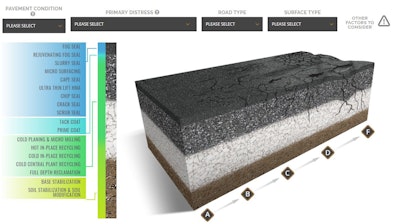
After three years of research and development, the Pavement Preservation & Recycling Alliance (PPRA) unveiled roadresource.org. The website was designed to help asset managers and agencies better plan and care for their deteriorating networks.
“We first started out by looking at what successful road managers and agencies were doing when it came to using recycled materials and preservations treatments and took those traits to build an online resource that everyone can learn from,” Lindsay Matush, CEO of Vario Marketing says.
The site was designed to help pavement asset managers expand their understanding of various asphalt treatments and solutions, helping them to know when to use what treatment and also give them the technical information and best practices they need to apply the treatment successfully.
“In our research, agencies indicated there was so much good information out there that it was overwhelming to try to access the data, Matush says. “We wanted to give agencies a consistent and easy to understand resource where they could find what they needed.”
Network Optimization
RoadResource.org features different calculators that help asset managers figure out how to optimize their network. Each calculator helps managers to apply smart strategies that can stretch their resources further.
Which Treatment is Best:
The Pavement Criteria tool is designed to explore cost-effective solutions to pavement at varying levels of distress. Users can input pavement criteria such as primary distress, road and surface type to be given potential solutions relevant to that roadway.
“As you enter criteria around your road, treatments that are no longer applicable based on the parameters you enter will gray out leaving you with options that could be potential solutions,” Matush says.
Each solution you are left with takes you to a high-level description of the treatment along with a cost-benefit analysis.
Life Cycle Cost:
Understanding the life cycle of your roadway and what you can do to help extend that life can help contractors realize the impact of cost-savings over time. The calculator helps you to see exactly where that road will start experiencing accelerated deterioration and gives options of what to do to prevent a costly mill and fill.
“If we can apply a series of preservation treatments that can help us to get ahead of that deterioration curve, agencies across the board can achieve 40-50 years of life which has the potential to save taxpayers $125M over the life of the roadway,” Matush says.
The calculator allows managers to compare the cumulative impact of less frequent maintenance under a worst-first approach with a preservation approach that treats and preserves your road every few years. Users can input different treatment types to see what type of cost savings they could achieve.
Remaining Service Life:
Most agencies are not going to see their budgets increase overtime, so they are tasked with doing more work with less money as their assets continue to deteriorate.
“Agencies have to do the slow, hard work of incremental change that helps them to spend the same amount of money, just differently, to help reverse a deteriorating network,” Matush says.
Understanding Remaining Service Life (RSL) is critical to designing a treatment plan that stretches your budget further and reverses the trend of a deteriorating network. The RSL calculator lets managers explore how different treatment combinations can be varied to inject maximum life into their network and use their resources more wisely.
Cost Benefit Value:
Deciding which projects need to be a priority in the year can be tough when you look at the budget dollars you have to work with. The Cost Benefit Value (CBV) calculator offers roadway managers a way to prioritize projects while accounting for the variables relevant to them and the realities of traffic, cost and life extension.
The CBV calculator reprioritizes costly projects and suggests the utilization of efficient treatments over more roadways and adding new life to the network.
The website also features news, case-studies and ways to stay connected with PPRA so users continue to get the most out of the tool.
Learn more at www.roadresource.org




















